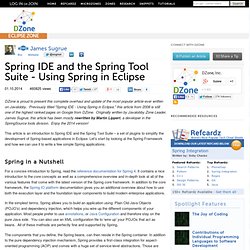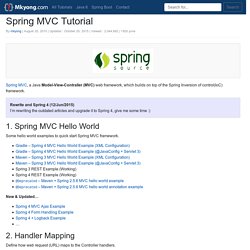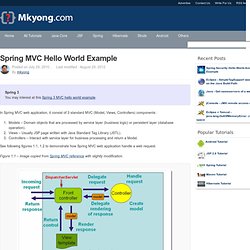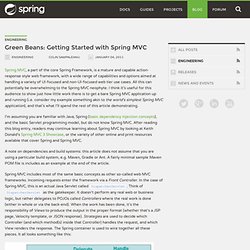

How to install Spring IDE in Eclipse. SpringIDE - Using Spring in Eclipse. We Recommend These Resources DZone is proud to present this complete overhaul and update of the most popular article ever written on Javalobby.

Previously titled "Spring IDE - Using Spring in Eclipse," this article from 2008 is still one of the highest ranked pages on Google from DZone. Originally written by Javalobby Zone Leader, James Sugrue, this article has been mostly rewritten by Martin Lippert, a developer in the SpringSource tools division. Enjoy the 2014 version! This article is an introduction to Spring IDE and the Spring Tool Suite – a set of plugins to simplify the development of Spring-based applications in Eclipse. Spring in a Nutshell For a concise introduction to Spring, read the reference documentation for Spring 4. In the simplest terms, Spring allows you to build an application using Plain Old Java Objects (POJO's) and dependency injection, which helps you wire up the different components of your application. Spring MVC Tutorials.
Spring MVC, a Java Model-View-Contraller (MVC) web framework, which builds on top of the Spring Inversion of control(IoC) framework.

Rewrite and Spring 4 (12/Jun/2015) I’m rewriting the outdated articles and upgrade it to Spring 4, give me some time :) 1. Spring MVC Hello World Some hello world examples to quick start Spring MVC framework. New & Updated… 2. Define how web request (URL) maps to the Controller handlers. BeanNameUrlHandlerMapping example Maps the requested URL to the name of the cocntroller. 3. Controller class to handle the web request. MultiActionController example Group related actions into a single controller class. 4. Resolve “view name” that returned from the controller class to a physical view page or JSP page. InternalResourceViewResolver example Adding a predefined prefix and suffix to the view name (prefix + view name + suffix), and generate the final view page URL. Spring MVC hello world example. In Spring MVC web application, it consist of 3 standard MVC (Model, Views, Controllers) components : Models – Domain objects that are processed by service layer (business logic) or persistent layer (database operation).Views – Usually JSP page written with Java Standard Tag Library (JSTL).Controllers – Interact with service layer for business processing and return a Model.

See following figures 1.1, 1.2 to demonstrate how Spring MVC web application handle a web request. Figure 1.1 – Image copied from Spring MVC reference with slightly modification. Figure 1.2 – P.S Image copied from book : Spring Recipes Note In Spring MVC , the core disatcher component is the “DispatcherServlet“, which act as the front-controller (design pattern). Green Beans: Getting Started with Spring MVC. Spring MVC, a part of the core Spring Framework, is a mature and capable action-response style web framework, with a wide range of capabilities and options aimed at handling a variety of UI-focused and non-UI-focused web tier use cases.

All this can potentially be overwhelming to the Spring MVC neophyte. I think it's useful for this audience to show just how little work there is to get a bare Spring MVC application up and running (i.e. consider my example something akin to the world's simplest Spring MVC application), and that's what I'll spend the rest of this article demonstrating. I'm assuming you are familiar with Java, Spring (basic dependency injection concepts), and the basic Servlet programming model, but do not know Spring MVC. Spring Framework. The Spring Framework is an open source application framework and inversion of control container for the Java platform.

The framework's core features can be used by any Java application, but there are extensions for building web applications on top of the Java EE platform. Although the framework does not impose any specific programming model, it has become popular in the Java community as an alternative to, replacement for, or even addition to the Enterprise JavaBean (EJB) model. Version history[edit] Modules[edit] The Spring Framework includes several modules that provide range of services: Inversion of control container (dependency injection)[edit] Objects created by the container are also called managed objects or beans. In many cases one need not use the container when using other parts of the Spring Framework, although using it will likely make an application easier to configure and customize.
Aspect-oriented programming framework[edit] Data access framework[edit]